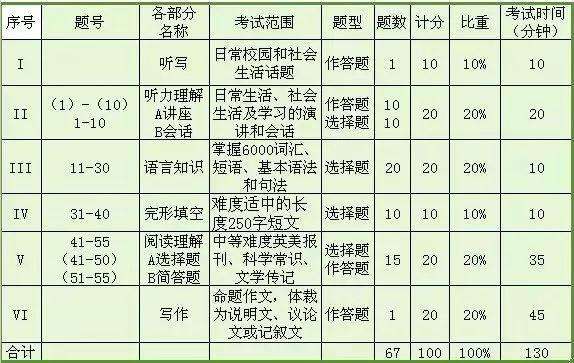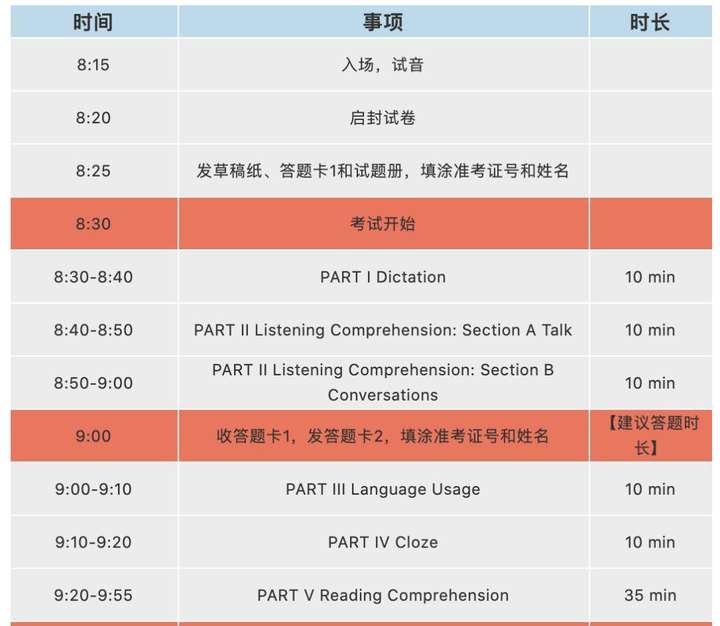
专四考试流程



第一阶段
全面了解新版考试+背词
1、全面了解考试(Now)
首先,找到2020版TEM最新真题试卷,了解2015年之后的最新考试结构。
专四听力题型为三种,语词题型为两种,阅读包含精读单选及简答,写作变身为总结评论型作文,共计八种题型。
2、背词(Now~直到考前)
词汇重要性不必多言,考生可以考虑购进专门针对TEM的词汇书开始热身或进行循环式词汇复习。
考研雅思托福等词汇和专四专八词汇确实有重叠性,能力处于中上或者同步备考上述考试的同学一本词汇书足矣。知识兔专注帮你学习,知识兔承包了你大学时光职业生涯所需要的学习资料、考试资料、课程教程、培训网课、素材模板、软件下载、电子书等等。

第二阶段:真题备考 (至20年12月底)
专四考试题型分析
(1)听力
PART I Dictation
听写材料为相对独立的篇章,长度大约80~90个单词,分10个意群(10句)。录音朗读四遍:第一、四遍为正常语速(120个单词/分钟);第二、三遍为慢速朗读,按意群断开,句间停顿15秒。
【答题小贴士】
听第一遍时,重点听主题思想和重点词,掌握全文大意。第二遍和第三遍朗读是以意群为单位重复的,第二遍听时要以意群为单位去理解。时间有限,不可能一次记下全部单词,要分清主次信息,抓句型和关键词(主语、谓语等)。
第三遍时把其他部分如修饰语、定冠词等遗漏内容补上,若有些词还来不及写,可先用自己明白的缩略形式甚至特殊符号代替,等最后一遍核查或结束前两分钟检查时再补写出原形。
1. 把握每一遍录音。如果在听的过程中有个别词或词组一下子反应不出来,就不要苦苦纠缠单个词,要跟着录音进行下一意群的听写,因为听写评阅标准中每个意群最多扣一分,所以某个意群中的个别单词或词组的错误或遗漏不会影响其他意群的得分。而对于听不懂的单词,不妨先根据读音写下音标,等回头检查时再想。知识兔专注帮你学习,知识兔承包了你大学时光职业生涯所需要的学习资料、考试资料、课程教程、培训网课、素材模板、软件下载、电子书等等。
2. 运用期待语法的作用。听之前,根据题目展开联想,调集大脑中储存的相关信息,同时仔细理解第一句,因为首句常是主题句,后边的句子围绕它进一步展开,这样可以适当缩小范围,更快进入状态。
3. 加强各种相关知识和技能的训练。听写是一项综合性语言技能,包含诸如听、写、词汇量、语法结构、篇章理解、记忆力等各方面,因此,提高听写能力的关键是加强各种相关知识和技能的训练。
4. 运用语法知识。有时即使没听出来,也可补写出来,如单复数和时态等。还可利用逻辑推理能力,因为所听材料都是有意义和独立成文的,因此,检查中如发现不合逻辑思维的句子,可以肯定所写有误,及时改正。
5. 注意书写的整洁、清晰。用指定水笔按要求书写。

PART II Listening Comprehension
听力理解由Talk填空和Conversations客观选择题组成。录音只放一遍!
—Section A:Talk
讲座类型文章,内容多为日常生活、社会生活和学习话题有关的演讲和会话。全文约500个单词,10道填空题。要求边听边做笔记。
1. 预测对话内容,建立心理预期。听力开始前,有30秒时间快速浏览题目,这时可以大致了解这篇听力的话题,预测接下来的对话内容,对部分填空也可猜测应该填入的单词或词组的词性。
2. 抓住主题,留意实词。文章的开头和结尾通常是对讲座主题的总述,从这里可以把握全文主旨大意。一般需要填写的关键词多为实词,主要是名词、动词、形容词或一些细节性描述词汇。
3. 表示顺序的词句后面是要点。如“First of all,...”“The second point is...”“Thirdly....”“In conclusion,...”等,这些词句后面都是关键,切记!!
4. 速记单词。虽然没必要专门去学习速记,但可从中借鉴一些简单的符号和缩写方法,如medicine记为med、information记为info,必须自己能看懂!
5. 注意细节,避免失分。尤其注意单复数、定冠词等,就算写出了后面那些长词,但若听漏了这些小细节,同样会失分。知识兔专注帮你学习,知识兔承包了你大学时光职业生涯所需要的学习资料、考试资料、课程教程、培训网课、素材模板、软件下载、电子书等等。
—Section B:Conversations
两段约450个单词的会话,每段各有5道选择题,每道题后有10秒间隙,要求听到问题后从所给四个选项中选出一个最佳答案(多选作废)。录音语速为每分钟约120个单词。会话与问题均只念一遍(问题不会出现在试卷上)。
1. 利用短暂时间。在播放指令或两道题之间停顿的那段时间,快速浏览4个选项,大致猜测文章背景和可能会问的问题。
2. 分析选项语法结构,判断提问方式。选择题出题基本原则是,每个备选项都可以完整回答对应题目的问题。是动词、名词(数词)、形容词选项,还是介词选项?是because、that等引导的从句选项,还是独立的句子选项?或是背景辨认题、事实细节题、原因推理题、观点态度题、行动计划题?
3. 边听边记笔记。听到和选项有关或可能的出题点,可以适当做笔记,特别是数字、时间、日期、地点、人名,表达情感和态度的词也要留意,说话者可能会通过用词的褒贬来表达情感。
改革后的专四出题思路跟以前差别很大,所以手里的专四老题绝对不能再做了。多做模拟题,练习短时间内通过选项猜测问句的技能。多总结校园、工作热门场景的单词。最关键的还是,多跟读裸听,提升真正的听力实力。

(2)选词及语法词汇
给你一个标准:在这一个月内,语法词汇及选词题目至少做完两遍并且在重新做时没有任何错误。想拿高分的学友,看是否可以达到能轻易分辨出近似干扰选项词汇的区别。知识兔专注帮你学习,知识兔承包了你大学时光职业生涯所需要的学习资料、考试资料、课程教程、培训网课、素材模板、软件下载、电子书等等。
PART III Language Usage
这部分包括20道单选选择题,50%为语法、短语用法题,其余为语法结构题。考生需掌握3000~4000个单词的基本搭配。主要包括以下题型:
一、近义词辨析题
表示“真实的”的形容词可以有true、genuine、real等,含义上彼此有差异,用法也不尽相同,比如:true强调“符合真理的、正确的”,genuine强调“非人造的、货真价实的”,real则强调“事件的真实性”,可理解为“显示的、并非虚假的”。做题时要注意结合考题上下文,选择符合要求的词汇。
二、词根词缀辨析题
英语单词的构成可包含三个成分:前缀+词根+后缀。以respectable(体面的、高尚的、值得尊敬的)为例:“re-”是前缀,表示“重复做某动作”;“spect”是词根,意思是一个动作——“看”;“-able”是后缀,首先揭示了该单词的词性是形容词,另外,此后缀意思是“能够……的、值得……的”。知识兔专注帮你学习,知识兔承包了你大学时光职业生涯所需要的学习资料、考试资料、课程教程、培训网课、素材模板、软件下载、电子书等等。
英语中,很多单词含有相同的词根,即含义上有一定的联系性,此时就比较难判断词义用法。平时复习时,要重点积累这类含有相同词根的词汇,背单词时要学会掌握常见词根、前缀、后缀的含义,解题时才能运用构词法知识来判断词语含义。

三、动词词组题
动词词组永远是考试的重点,尤其要注意同一个动词与不同介词组合可结合成含义不同的词组。以动词give为例:give out表示“分发物品”;give off表示“散发出光芒或气味”;give up表示“放弃”;give in表示“屈服、投降、让步”。考题常给出一个动词,而用什么介词与之搭配,就需要考生在选项中选词填空。因此,考生在背单词时,需要专门花时间积累“动词+介词”词组。
四、从句引导词题
英语的从句包括主语从句、表语从句、状语从句、定语从句、同位语从句、宾语从句等。根据从句部分在句子里不同的表意作用,又可细分为更多类型。
各种从句都有各自常用的引导词,如:限定性定语从句常用that引导,非限定性定语从句常用which引导,条件状语从句常用if引导,主语从句常用what引导等。要根据上述从句分类,搞清常用的引导词用法。
五、形近词辨析题
这类题目指在选项中故意安插拼写形式相近、容易混淆的单词,让考生辨别。如virtual与visual,前者表示“实质上的”,后者表示“视觉的”。必须具备扎实的词汇基本功,才能清晰判断单词的拼写形式。

PART IV Cloze
文章长约250到300个单词,10个空格,备选词15个,每个空格只准选用一个单词,不能重复使用,即15选10。备选词汇为名词、动词、形容词和副词,虚词不在考核范围内。知识兔专注帮你学习,知识兔承包了你大学时光职业生涯所需要的学习资料、考试资料、课程教程、培训网课、素材模板、软件下载、电子书等等。
【答题小贴士】
1. 按照词缀准确判断15个单词的词性,将同一词性备选单词归为一组,如果遇到动词还可以按照时态进行二次分类。
2. 只读试题所在的原句,通过前后词判断空内应填词的词性和语法属性,通过上下句判断时态,回到对应词性组选择单词,动词注意时态。
3. 本题并不侧重考察同义词辨析和固定搭配,因此只要能判断试题所在句子所需要的词性和语法属性就不难找到正确答案。
4. 未必按顺序作题,只读句子,哪个简单先做哪个,难的后做,备选范围会不断缩小。
5. 正确答案应满足语法和词性要求,句意通顺。

(3)阅读
PART V Reading Comprehension
阅读由3~4篇文章组成(不确定),每篇约400个单词。形式为选择题和简答题,其中简答题基于阅读语篇回答5个问题,要求答案不超过10个单词。
这部分考核考生掌握相关阅读策略和阅读技巧的程度,考生须有通过阅读获取有关信息及概括大意的能力,既要求阅读准确性,也要求阅读速度。
【答题小贴士】
1. 略读(skimming)。不需要仔细阅读全文每一个词,而是选择性阅读。主要作用是了解文章大意。通过略读,能大大提高阅读速度,也能获得大量信息。略读训练最简单的方法就是强迫自己在规定时间内读完某篇文章,在不断训练的过程中逐渐缩短规定时间。略读时注意力要高度集中,努力捕捉那些能引起你注意或者你认为重要的内容。
2. 扫读(scanning)。以最快速度扫视所读材料,在找到所需信息时才仔细阅读相关内容。在寻找特定信息、具体事实或答题所需内容(如某个人名、地名、时间、地点等)时,可用这种方法。
3. 研读(study reading)。仔细阅读,透彻理解所读内容。根据考题,运用上下文、逻辑关系、背景知识判断和推论。对难句的理解和翻译建议采用这种方法。知识兔专注帮你学习,知识兔承包了你大学时光职业生涯所需要的学习资料、考试资料、课程教程、培训网课、素材模板、软件下载、电子书等等。
4. 扩大词汇量。词汇量大小会影响阅读理解能力,词汇量越大,阅读越广,视野越开阔,阅读理解的得分就越高。多读是扩大词汇量的最好方法。不仅要读不同体裁的书和文章,还要多接触不同题材,才能适应考试需要。如果能通过上下文(比如句子、段落或文章)来理解并掌握词汇和短语,效果更佳。

(4)写作
写作是一个先输入再输出的过程,所以建议考前阅读范文,积累并背诵范文中的高级词汇以及功能句,重点了解专四新版写作题目的三段式(summary+观点+论证)的写法。
3月将专四作文十年写作题目归纳类型进行练习,每周两篇文章的实际操练,参阅范文,找出差距。4月背诵万能功能句,总结功能段,重新改写3月写过的文章,尝试提高之前文章的语言质量。
相对而言,专四难度比专八小,但是本着为专八努力的方向,打好基础,以后会轻松。

PART VI Writing
根据所给的作文题目、图表或阅读材料等,按照具体要求写一篇200个单词左右的短文,做到文字相关、内容充实、语言通顺、用词恰当、表达得体。
【答题小贴士】
1. 认真审题,磨刀不误砍柴工。
审题至关重要,最好先花两三分钟构思,既有利于理清行文思路,也可避免差之毫厘、失之千里的遗憾。所谓审题,即通过阅读写作题目或所给材料,正确领会题目含义,了解题目要求,明确写作目的,为构思符合要求的文章思路及框架打下基础。审题不是仅仅浏览一个标题,而要兼顾观点、情景、标题、写作要求等因素。
2. 注意行文的统一性和连贯性。
主要体现在作文的内容和框架结构上。一篇优秀的作文应该具备这样的特点,这也是阅卷老师评分的重要标准。按照写作要求,合格的作文由三部分组成。
具体如下:
①第一部分,明确、清楚地阐述作者的论点;
②第二部分,作文主体,通过恰当的语篇模式(如cause and effect、comparison and contrast等)论证前面提出的论点,论证过程做到结构严谨、层次分明、合乎逻辑,抓住中心并围绕中心展开讨论,观点阐述要合乎情理,观点之间衔接自然顺畅;
③第三部分,作文结尾,一般应是对前面部分的总结,因此应与前面部分保持论点的一致性和统一性,如果缺乏连贯性,会破坏作文的完整性,影响得分。


第三阶段:冲刺备考 (4月初)
第一、继续完成上个阶段未完成的真题,或者复习那些做过的题目;
第二、熟悉流程比什么都重要。
多说几句:
第一,专四和六级题型结构差别巨大,无可比性。但是从证书/成绩单认可度而言,六级完胜专四(你可以说最直接原因就是六比四强);所以,考专四的,为了避免以后殒命专八,建议你同步备考六级。
版权声明
来源:英语世界、建昆老师、华南翻译市场。<蔡雷英语>编辑
感谢作者原创,如涉版权请联系小编删除处理。
TEST FOR ENGLISH MAJORS (2010)
-GRADE FOUR-
TIME LIMIT: 135 MIN
PART I DICTATION [15 MIN]
Listen to the following passage. Altogether the passage will be read to you four times. During the first reading, which will be done at normal speed, listen and try to understand the meaning? For the second and third readings, the passage will be read sentence by sentence, or phrase by phrase, with intervals of 15 seconds. The last reading will be done at normal speed again and during this time you should check your work. You will then be given 2 minutes to check through your work once more.
Please write the whole passage on ANSWER SHEET.
SECTION A CONVERSATIONS
In this section you will hear several conversations. Listen to the conversations carefully and
then answer the questions that follow.
Questions 1 to 3 are based on the following conversation. At the end of the conversation, you will be given 15 seconds to answer the questions. Now, listen to the conversation.
1. The following details have been checked during the conversation EXCEPT
A. number of travelers.
B. number of tour days.
C. flight details.
D. room services.
2. What is included in the price?
A. Air tickets and local transport.
B. Local transport and meals.
C. Air tickets, local transport and breakfast.
D. Air tickets, local transport and all meals.
3. Which of the following statements is CORRECT?
A. The traveler is reluctant to buy travel insurance.
B. The traveler is ready to buy travel insurance.
C. The traveler doesn't have to buy travel insurance.
D. Travel insurance is not mentioned in the conversation.
Questions 4 to 7 are based on the following conversation. At the end of'the conversation, you will be given 20 seconds to answer the questions. Now, listen to the conversation.
4. Which of the following details is CORRECT?
A. Mark knows the exact number of airport buses.
B. Mark knows the exact number of delegates' spouse.
C. Mark doesn't know the exact number of delegates yet.
D. Mark doesn't know the number of guest speakers.
5. What does Linda want to know?
A. The arrival time of guest speakers.
B. The departure time of guest speakers.
C. The type of transport for guest speakers.
D. The number of guest speakers.
6. How many performances have been planned tbr the conference?
A. One.
B. Two.
C. Three.
D. Not mentioned.
7. Who will pay for the piano performance?
A. Pan-Pacific Tours.
B. Johnson & Sons Events.
C. Conference delegates.
D. An airline company.
Questions 8 to 10 are based on the following conversation. At the end of'the conversation,
you will be given 15 seconds to answer the questions. Now listen to the conversation.
8. What is NOT missing in Mary's briefcase?
A. Her cheque book.
B. Her papers for work.
C. Her laptop.
D. Her appointment book.
9. Where was Mary the whole morning?
A. At the police station.
B. At a meeting.
C. In her client's office.
D. In the restaurant.
10. Why was Mary sure that the briefcase was hers in the end?
A. The papers inside had the company's name.
B. The briefcase was found in the restaurant.
C. The restaurant manager telephoned James.
D. The cheque book inside bore her name.
SECTION B PASSAGES
In this section, you will hear several passages. Listen to the passages carefully and then answer the questions that follow.
Questions 11 to 13 are based on the following passage. At the end of the passage, yott will be given 15 seconds to answer the questions. Now, listen to the passage.
11. We learn from the passage that about two-thirds of the courses are taught through
A. the School of Design and Visual Arts.
B. the School of Social Work.
C. the School of Business.
D. the Arts and Sciences program.
12.What is the cost of undergraduate tuition?
A. Twenty thousand dollars.
B. Thirty thousand dollars.
C. Twenty-seven thousand dollars.
D. Thirty-eight thousand dollars.
13.International students can receive all the following types of financial assistance EXCEPT
A. federal loans.
B. private loans.
C. scholarships.
D. monthly payment plans.
Questions 14 to 17 are based on the following passage. At the end of the passage, you will be
given 20 seconds to answer the questions. Now, listen to the passage.
14. According to the passage, mothers in ____ spend more time looking after children.
A. France
B. America
C. Denmark
D. Australia
15. Which of the following activities would Australian fathers traditionally participate in?
A. Feeding and playing with children.
B. Feeding and bathing children.
C. Taking children to the park and to school.
D. Taking children to watch sports events.
16. According to the study, the "new man" likes to
A. spend more time at work.
B. spend more time with children.
C. spend time drinking after work.
D. spend time on his computer.
17.It is suggested in the passage that the "new man" might be less acceptable in
A. France.
B. Britain.
C. Australia.
D. Denmark.
Questions 18 to 20 are based on the following passage. At the end of the passage, you will be given 15 seconds to answer the questions. Now, listen to the passage.
18.The services of the new partnership are provided mainly to
A. mothers of infected babies.
B. infected children and women.
C. infected children in cities.
D. infected women in cities.
19.Which of the following details about Family Health International is INCORRECT?
A. It is a nonprofit organization.
B. It provides public health services.
C. It carries out research on public health.
D. It has worked in five countries till now.
20.The example of Cambodia mainly shows
A. the importance of government support.
B. the importance of public education efforts.
C. the progress the country has made so far.
D. the methods used to fight AIDS.
SECTION C NEWS BROADCAST
In this section, you will hear several news items. Listen to them carefully and then answer the
questions that follow.
Questions 21 and 22 are based on the following news. At the end of the news item, you will be given 10 seconds to answer the questions. Now. listen to the news.
21. According to the news, the victim was
A. a 17-year-old girl.
B. a 15-year-old boy.
C. a 23-year-old woman.
D. an l 8-year-old man.
22.We learn from the news that the suspects were arrested
A. one month later.
B. two months later.
C. immediately.
D. two weeks later.
Questions 23 and 24 are based on the following news. At the end of the news item, you will be
given 10 seconds to answer the questions. Now, listen to the news.
23.The Iraqi parliament can vote on the security agreement only after
A. all parties have agreed on it.
B. the US troops have pulled out.
C. the cabinet has reviewed it.
D. the lawmakers have returned from Mecca.
24.According to the news, the US troops are expected to completely pull out by
A. mid-2009.
B. the end of 2009.
C. mid-2011.
D. the end of 2011.
Questions 25 and 26 are based on the following news. At the end of the news item, you will be
given 10 seconds to answer the questions. Now, listen to the news.
25.The following are involved in the operations to rescue the children in Honduras EXCEPT
A. the police.
B. the district attorney.
C. the prison authorities.
D. Institute of Childhood and Family.
26. What punishment would parents face if they allowed their children to beg?
A. To be imprisoned and fined.
B. To have their children taken away.
C. To be handed over to the authorities.
D. None.
Question 27 is based on the following news. At the end of the news item. you will be given 5
seconds to answer the question. Now, listen to the news.
27.What is the news item about?
A. Coastlines in Italy.
B. Public use of the beach.
C. Swimming and bathing.
D. Private bathing clubs.
Question 28 is based on the following news. At the end of the news item, you will be given 5
seconds to answer the question. Now, listen to the news.
28.Which of the following is NOT mentioned in the news?
A. The airport was shut down for Friday.
B. There was a road accident involving two buses.
C. Local shops were closed earlier than usual.
D. Bus service was stopped for Friday.
Questions 29 and 30 are based on the following news. At the end of the news item, you will be
given 10 seconds to answer the questions. Now, listen to the news.
29.How many people were rescued from the apartment building?
A. 17.
B. 24.
C. 21.
D. 41.
30.Which of the following details in the news is CORRECT?
A. The rescue operation involved many people.
B. The cause of the explosions has been determined.
C. Rescue efforts were stopped on Thursday.
D. The explosions didn't destroy the building.
PARTⅡ CLOZE [20 MIN]
Decide which of the choices given below would best complete the passage if inserted in the corresponding blanks. Mark the best choice for each blank on ANSWER SHEET.
How men first learned to invent words is unknown; (31)_____, the origin of language is a mystery. All we really know is that men, unlike animals, somehow invented certain (32)_____to express thoughts and feelings, actions and things, (33)_____they could communicate with each other; and that later they agreed (34)_____certain signs, called letters, which could be (35)_____to represent those sounds, and which could be (36)_____. Those sounds, whether spoken, (37)_____written in letters, we call words.
The power of words, then, lies in their (38)_____ -the things they bring up before our minds. Words become (39)_____with meaning for us by experience; (40)_____the longer we live, the more certain words (41)_____to us the happy and sad events of our past; and the more we (42)_____, the more the number of words that mean something to us (43)_____.
Great writers are those who not only have great thoughts but also express these thoughts in words which appeal (44)_____to our minds and emotions. This (45)_____and telling use of words is what we call (46)_____style. Above all, the real poet is a master of (47)_____. He can convey his meaning in words which sing like music, and which (48)_____their position and association can (49)_____men to tears. We should, therefore, learn to choose our words carefully and use them accurately, or they will (50)_____our speech or writing silly and vulgar.
(31) A. in addition B. in other words C. in a word D. in summary
(32) A. sounds B. gestures C. signs D. movements
(33) A. such that B. as that C. so that D. in that
(34) A. in B. with C. of D. upon
(35) A. spelt B. combined C. written D copied
(36) A. written down B. handed down C. remembered D. observed
(37) A. and B. yet C. also D. or
(38) A. functions B. associations C. roles D. links
(39) A. filled B. full C. live D. active
(40) A. but B. or C. yet D. and
(41) A. reappear B. recall C. remember D. recollect
(42) A. read and think B. read and recall C. read and learn D. read and recite
(43) A. raises B. increases C. improves D. emerges
(44) A. intensively B. extensively C. broadly D. powerfully
(45) A. charming B. academic C. conventional D. common
(46) A. written B. spoken C. literary D. dramatic
(47) A. signs B. words C. style D. sound
(48) A. in B. on C. over D. by
(49) A. move B. engage C. make D. force
(50) A. transform B. change C. make D. convert
PART Ⅲ GRAMMAR & VOCABULARY [25 MIN]
There are thirty sentences in this section. Beneath each sentence there are four words or phrases marked A, B, C and D. Choose one word or phrase that best completes the sentence.
Mark your answers on ANSWER SHEET.
51. Which of the following italicized phrases indicates CAUSE?
A. Why don't you do it for the sake of your friends?B. I wish I could write as well as you.
C. For all his efforts, he didn't get an A.D. Her eyes were red from excessive reading.
52. Nancy's gone to work but her car's still there. She_____ by bus.
A. must have gone B. should have goneC. ought to have gone D. could have gone
53. He feels that he is not yet_____ to travel abroad.
A. too strong B. enough strong C. so strong D. strong enough
54. After_____ seemed an endless wait, it was his turn to enter the personnel manager's office.
A. that B. it C. what D. there
55. Fool_____ Jerry is, he could not have done such a thing.
A. who B. as C. like D. that
56. Which of the following sentences is INCORRECT?
A. They each have two tickets.B. They cost twenty yuan each.
C. Each they have bought the same book.D. They were given two magazines each.
57. She seldom goes to the theatre,_____?
A. doesn't she B. does she C. would she D. wouldn't she
58. Dr Johnson is head of the department,_____an expert in translation.
A. or B. either C. but D. and
59. When one has good health,_____should feel fortunate.
A. you B. they C. he D. we
60. It is necessary that he_____ the assignment without delay.
A. hand in B. hands inC. must hand in D. has to hand in
61. In the sentence "It's no use waiting for her", the italicized phrase is
A. the object B. an adverbial C. a complement D. the subject
62. Which of the following sentences is INCORRECT?
A. All his lectures are very interesting.B. Half their savings were gone.
C. Many his friends came to the party.D. Both his sisters are nurses.
63. Which of the following sentences has an object complement?
A. The directors appointed John manager.B. I gave Mary a Christmas present.
C. You have done Peter a favour.D. She is teaching children English.
64. Which of the following words can NOT be used to complete "We've seen the film_____"?
A. before B. recently C. lately D. yet
65._____should not become a serious disadvantage in life and work.
A. To be not tall B. Not being tall
C. Being not tall D. Not to be tall
66. Due to personality_____, the two colleagues never got on well in work.
A. contradiction B. conflict C. confrontation D. competition
67. During the summer vacation, kids are often seen hanging_____ in the streets.
A. about B. on C. over D. out
68. There were 150_____ at the international conference this summer.
A. spectators B. viewers C. participants D. onlookers
69. School started on a_____ cold day in February.
A. severe B. bitter C. such D. frozen
70. In the face of unexpected difficulties, he demonstrated a talent for quick,_____ action.
A. determining B. defensive C. demanding D. decisive
71. The team has been working overtime on the research project
A. lately B. just now C. late D. long ago
72. Because of the economic crisis, industrial output in the region remained
A. motionless B. inactive C. stagnant D. immobile
73. The police had difficulty in_____ the fans from rushing on to the stage to take photos with the singer.
A. limiting B. restraining C. confining D. restricting
74. Joan is in the dorm, putting the final_____ to her speech.
A. details B. remarks C. comments D. touches
75. His_____ in gambling has eventually brought about his ruin.
A. indulgence B. habit C. action D. engagement
76. The teacher told the students to stay in the classroom and they did
A. absolutely B. accidentally C. accordingly D. accurately
77. You can actually see the deer at close range while driving through that area. The italicized phrase means_____.
A. clearly B. very near C. quickly D. very hard
78. He listened hard but still couldn't_____ what they were talking about.
A. make over B. make up C. make upon D. make out
79. For the advertised position, the company offers a(n)_____ salary and benefits package.
A. generous B. plentiful C. abundant D. sufficient
80. As there was no road, the travelers_____ up a rocky slope on their way back.
A. ran B. hurried C. scrambled D. crawled
PART Ⅳ READING COMPREHENSION [35 MIN]
In this section there are four passages followed by questions or unfinished statements, each with four suggested answers marked A, B, C and D. Choose the one that you think is the best answer.
Mark your answers on ANSWER SHEET.
TEXT A
What is the nature of the scientific attitude, the attitude of the man or woman who studies and applies physics, biology, chemistry, geology, engineering, medicine or any other science?
We all know that science plays an important role in the societies in which we live. Many people believe, however, that our progress depends on two different aspects of science. The first of these is the application of the machines, products and systems of applied knowledge that scientists and technologists develop. Through technology, science improves the structure of society and helps man to gain increasing control over his environment.
The second aspect is the application by all members of society of the special methods of thought and action that scientists use in their work.
What are these special methods of thinking and acting? First of all, it seems that a successful scientist is full of curiosity - he wants to find out how and why the universe works. He usually directs his attention towards problems which he notices have no satisfactory explanation, and his curiosity makes him look for underlying relationships even if the data available seem to be unconnected. Moreover, he thinks he can improve the existing conditions and enjoys trying to solve the problems which this involves.
He is a good observer, accurate, patient and objective and applies logical thought to the observations he makes. He utilizes the facts he observes to the fullest extent. For example, trained observers obtain a very large amount of information about a star mainly from the accurate analysis of the simple lines that appear in a spectrum.
He is skeptical - he does not accept statements which are not based on the most complete evidence available - and therefore rejects authority as the sole basis for truth. Scientists always check statements and make experiments carefully and objectively to verify them.
Furthermore, he is not only critical of the work of others, but also of his own, since he knows that man is the least reliable of scientific instruments and that a number of factors tend to disturb objective investigation.
Lastly, he is highly imaginative since he often has to look for relationships in data which are not only complex but also frequently incomplete. Furthermore, he needs imagination if he wants to make hypotheses of how processes work and how events take place.
These seem to be some of the ways in which a successful scientist or technologist thinks and acts.
81. Many people believe that science helps society progress through
A. applied knowledge.B. more than one aspect.
C. technology only.D. the use of machines.
82. Which of the following statements is INCORRECT about curiosity?
A. It gives the scientist confidence and pleasure in work.
B. It gives rise to interest in problems that are unexplained.
C. It leads to efforts to investigate potential connections.
D. It encourages the scientist to look for new ways of acting.
83. According to the passage, a successful scientist would not
A. easily believe in unchecked statements.B. easily criticize others' research work.
C. always use his imagination in work.D. always use evidence from observation
84. What does the passage mainly discuss?
A. Application of technology.B. Progress in modem society.
C. Scientists' ways of thinking and acting.D. How to become a successful scientist.
85. What is the author's attitude towards the topic?
A. Critical.B. Objective.C. Biased.D. Unclear.
TEXT B
Over the past several decades, the U.S., Canada, and Europe have received a great deal of media and even research attention over unusual phenomena and unsolved mysteries. These include UFOs as well as sightings and encounters with "nonhuman creatures" such as Bigfoot and the Loch Ness monster. Only recently has Latin America begun to receive some attention as well. Although the mysteries of the Aztec, Mayan, and Inca civilizations have been known for centuries, now the public is also becoming aware of unusual, paranormal phenomena in countries such as Peru.
The Nazca“lines” of Peru were discovered in the 1930s. These lines are deeply carved into a flat, stony plain, and form about 300 intricate pictures of animals such as birds, a monkey, and a lizard. Seen at ground level, the designs are a jumbled senseless mess. The images are so large that they can only be viewed at a height of 1,000 feet - meaning from an aircraft. Yet there were no aircraft in 300 B.C., when it is judged the designs were made. Nor were there then, or are there now, any nearby mountain ranges from which to view them. So how and why did the native people of Nazca create these marvelous designs? One answer appeared in 1969, when the German researcher and writer Erich von Daniken proposed that the lines were drawn by extraterrestrials as runways for their aircraft. The scientific community did not take long to scoff at and abandon von Daniken's theory. Over the years several other theories have been put forth, but none has been accepted by the scientific community.
Today there is a new and heightened interest in the Nazca lines. It is a direct result of the creation of the Interment. Currently there are over 60 sites dedicated to this mystery from Latin America's past, and even respected scientists have joined the discussion through e-mail and chat rooms.
Will the Interment help explain these unsolved mysteries? Perhaps it is a step in the right direction.
86. Which of the following statements is INCORRECT?
A. Latin America has long received attention for unusual phenomena.
B. Public attention is now directed towards countries like Peru.
C. Public interest usually focuses on North America and Europe.
D. Some ancient civilizations have unsolved mysteries.
87. According to the passage, the Nazca lines were found
A. in mountains.B. in stones.C. on animals.D. on a plain.
88. We can infer from the passage that the higher the lines are seen, the_____ the images they present.
A. smallerB. largerC. clearerD. brighter
89. There has been increasing interest in the Nazca lines mainly because of
A. the participation of scientists.B. the emergence of the Interment.
C. the birth of new theories.D. the interest in the Interment.
90. The author is_____about the role of the Interment in solving mysteries.
A. cautiousB. pessimisticC. uncertainD. optimistic
TEXT C
Graduation speeches are a bit like wedding toasts. A few are memorable. The rest tend to trigger such thoughts as, "Why did I wear such uncomfortable shoes?"
But graduation speeches are less about the message than the messenger. Every year a few colleges and universities in the US attract attention because they've managed to book high-profile speakers. And, every year, the media report some of these speakers' wise remarks.
Last month, the following words of wisdom were spread:
"You really haven't completed the circle of success unless you can help somebody else move forward." (Oprah Winfrey, Duke University)
"There is no way to stop change; change will come. Go out and give us a future worthy of the world we all wish to create together." (Hillary Clinton, New York University)
"This really is your moment. History is yours to bend." (Joe Biden, Wake Forest University)
Of course, the real "get" of the graduation season was first lady Michelle Obama's appearance at the University of California, Merced. "Remember that you are blessed," she told the class of 2009, "Remember that in exchange for those blessings, you must give something back... As advocate and activist Marian Wright Edelman says, 'Service is the rent we pay for living ... it is the true measure, the only measure of success'."
Calls to service have a long, rich tradition in these speeches. However, it is possible for a graduation speech to go beyond clich6 and say something truly compelling. The late writer David Foster Wallace's 2005 graduation speech at Kenyon College in Ohio talked about how to truly care about other people. It gained something of a cult after it was widely circulated on the Interment. Apple Computer CEO Steve Jobs' address at Stanford University that year, in which he talked about death, is also considered one of the best in recent memory.
But when you're sitting in the hot sun, fidgety and freaked out, do you really want to be lectured about the big stuff? Isn't that like trying to maintain a smile at your wedding reception while some relative gives a toast that amounts to "marriage is hard work"? You know he's right; you just don't want to think about it at that particular moment. In fact, as is the case in many major life moments, you can't really manage to think beyond the blisters your new shoes are causing.
That may seem anticlimactic. But it also gets to the heart of one of life's greatest, saddest truths: that our most "memorable" occasions may elicit the fewest memories. It's probably not something most graduation speakers would say, but it's one of the first lessons of growing up.
91. According to the passage, most graduation speeches tend to recall_____ memories.
A. greatB. trivialC. unforgettableD. unimaginative
92. "But graduation speeches are less about the message than the messenger" is explained
A. in the final paragraph.B. in the last but one paragraph.
C. in the first paragraph.D. in the same paragraph.
93. The graduation speeches mentioned in the passage are related to the following themes EXCEPT
A. death.a. success.C. service.D. generosity.
94. It is implied in the passage that at great moments people fail to
A. remain clear-headed.B. keep good manners.
C. remember others' words.D. recollect specific details.
95. What is "one of the first lessons of growing up"?
A. Attending a graduation ceremony.B. Listening to graduation speeches.
C. Forgetting details of memorable events.D. Meeting high-profile graduation speakers.
TEXT D
Cultural rules determine every aspect of food consumption. Who eats together defines social units. For example, in some societies, the nuclear family is the unit that regularly eats together. The anthropologist Mary Douglas has pointed out that, for the English, the kind of meal and the kind of food that is served relate to the kinds of social links between people who are eating together. She distinguishes between regular meals, Sunday meals when relatives may come, and cocktail parties for acquaintances. The food served symbolizes the occasion and reflects who is present. For example, only snacks are served at a cocktail party. It would be inappropriate to serve a steak or hamburgers. The distinctions among cocktails, regular meals, and special dinners mark the social boundaries between those guests who are invited for drinks, those who are invited to dinner, and those who come to a family meal. In this example, the type of food symbolizes the category of guest and with whom it is eaten.
In some New Guinea societies, the nuclear family is not the unit that eats together. The men take their meals in a men's house, separately from their wives and children. Women prepare and eat their food in their own houses and take the husband's portion to the men's house. The women eat with their children in their own houses. This pattern is also widespread among Near Eastern societies.
Eating is a metaphor that is sometimes used to signify marriage. In many New Guinea societies, like that of the Lesu on the island of New Ireland in the Pacific and that of the Trobriand Islanders, marriage is symbolized by the couple's eating together for the first time. Eating symbolizes their new status as a married couple. In U.S. society, it is just the reverse. A couple may go out to dinner on a first date.
Other cultural rules have to do with taboos against eating certain things. In some societies, members of a clan, a type of kin (family) group, are not allowed to eat the animal or bird that is their totemic ancestor. Since they believe themselves to be descended from that ancestor, it would be like eating that ancestor or eating themselves.
There is also an association between food prohibitions and rank, which is found in its most extreme form in the caste system of India. A caste system consists of ranked groups, each with a different economic specialization. In India, there is an association between caste and the idea of pollution. Members of highly ranked groups can be polluted by coming into contact with the bodily secretions, particularly saliva, of individuals of lower-ranked castes. Because of the fear of pollution, Brahmans and other high-ranked individuals will not share food with, not eat from the same plate as, not even accept food from an individual from a low-ranking caste.
96. According to the passage, the English make clear distinctions between
A. people who eat together.B. the kinds of food served.
C. snacks and hamburgers.D. family members and guests.
97. According to the passage, who will NOT eat together?
A. The English.B. Americans on their first date.
C. Men and women in Near Eastern societies.D. Newly-weds on the island of New Ireland.
98. According to the passage, eating together indicates all the following EXCEPT
A. the type of food.B. social relations.C. marital status.D. family ties.
99. The last paragraph suggests that in India_____ decides how people eat.
A. pollutionB. foodC. cultureD. social status
100. Which of the following can best serve as the topic of the passage?
A. Different kinds of food in the world._____ B. Relations between food and social units.
C. Symbolic meanings of food consumption.D. Culture and manners of eating.
PART VI WRITING [45 MIN]
SECTION A COMPOSITION [35 MIN]
It was recently reported in a newspaper that six students who shared a dorm at a local university hired a cleaner to do laundry and cleaning once a week. And each of them paid her 60 yuan a month. This has led to a heated debate as to whether college students should hire cleaners.
Write on ANSWER SHEET THREE a composition of about 200 words on the following topic:
Should College Students Hire Cleaners?
You are to write in three parts.
In the first part, state clearly what your view is.
In the second part, support your view with appropriate reasons.
In the last part, bring what you have written to a natural conclusion or a summary.
Marks will be awarded for content, organization, grammar and appropriateness. Failure to follow the instructions may result in a loss of marks.
SECTION B NOTE-WRITING [10 MINI
Write on ANSWER SHEET THREE a note of about 50-60 words based on the following situation:
Your good friend, John, is thinking of organizing an end-of-the-term party. Write him a note telling him that you like his idea and offer to help him. You have to be specific about how you can help him.
Marks will be awarded for content, organization, grammar and appropriateness.
2010年英语专四参考答案
听力部分
1. D2. D 3. A 4. C 5. 6. 7. D8. 9. C10. D 11. D 12. B 13. A 14. D 15. D 16. B 17. C 18. B 19. D 20. A 21. C 22. B23. A 24. D 25. C26. A27. B 28. A 29. C30. A
完形填空部分
31 B 32 A33 C 34 D 35 B 36 A 37 D38 B 39 A 40 D
41 B 42 C43 B 44 D 45 A 46 C 47 B48 D 49 A 50 C
词汇和结构部分
51. D 52. A 53. D 54. C 55. B 56. C 57. B 58. D 59. C 60. A 61. D 62. C 63. A 64. D 65. B 66. B 67. D 68. C 69. B 70. D 71. A 72. C 73. D 74. D 75. A 76. C 77. B 78. D 79. A 80. C
阅读理解部分
81. B 82. A 83. A 84. C 85. B 86. A 87. D 88. C 89. B90.
D 91. B 92. D 93. D 94. C 95. C 96. D 97. C 98. A 99. D 100. D

